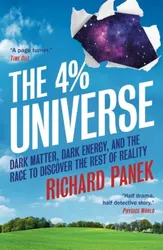The 4% Universe by Richard Panek tells the story of how astronomy and astrophysics developed in the 20th century, leading to the discovery that the visible part of the universe only makes up around 4% of what’s actually out there. The rest, it seems, is made up of dark matter and dark energy.
We go from Hubble’s discovery of other galaxies and the expansion of the universe, Georges Lemaître’s suggestion that this implies a Big Bang from which everything expanded, and the discovery of evidence for the big bang in the form of the Cosmic Microwave Background Radiation.
We get the story of Vera Rubin, and other astronomers, whose study of the behaviour of galaxies led to the conclusion that there is more mass in the universe than we can see; the stuff (although we don’t know what it is) that we call Dark Matter.
We get the story of various groups, including those of Saul Perlmutter, Adam Reiss and Brain Schmidt, whose study of supernovae led to the conclusion that there is something speeding up the expansion of the universe; the stuff (although we don’t know what it is) that we call Dark Energy.
The book covers a lot of detail about how this type of science is done, including some of the problems encountered, such as figuring out whether or not we can accurately determine the distance of supernovae based on their brightness. Much like in The Code Breaker, there is an uneasy cooperation between the two groups looking for supernovae in order to determine the change in the rate of expansion of the universe, and this tips into rivalry and acrimony once they both get close to a significant result.
In the process, I also learned quite a lot about the progress that astronomy made during the 20th century. At the start, it was more or less lone astronomers looking at the sky through telescopes, and maybe taking some photographs. Their idea of the universe was that it was static and just included the Milky Way galaxy. By the end, we had computer controlled telescopes in space, beaming digital images back to Earth, which were then automatically processed to find objects of interest, and the expanding universe contained hundreds of billions of galaxies.
It’s also the story of how physics and astronomy became intertwined, as astronomy went from simply observing the cosmos, to attempting to understand, explain and predict its behaviour. Better physical theories were then needed in order to do this. Now we have giant particle detectors underground, looking for something that could be dark matter. Really, the people running these experiments are doing astronomy, but it looks like a particle physics experiment.
I really enjoyed reading about the different scientists and discoveries that led to the theories about dark matter and dark energy. This book covers a lot of ground, and there are many scientists involved. It does a good job of giving us an idea of the personalities of these characters, but there are so many people involved in these discoveries that I got a bit lost with who everyone was at some points. But this just reflects the number of people who contributed to these discoveries.
Since dark matter and dark energy are still a mystery, we don’t get any answers by the end of the book. It was published in 2011, but so far scientists don’t seem to have settled on any particular explanations for these phenomena. One day I hope I can read a book about dark matter and dark energy that contains a full explanation of what they actually are! But until then, this is a good book to explain how we got to our current (lack of) understanding about these mysteries.
